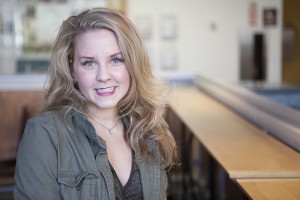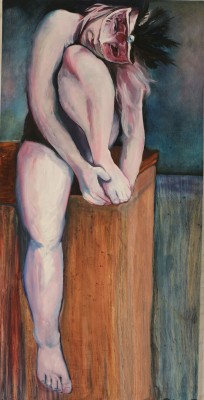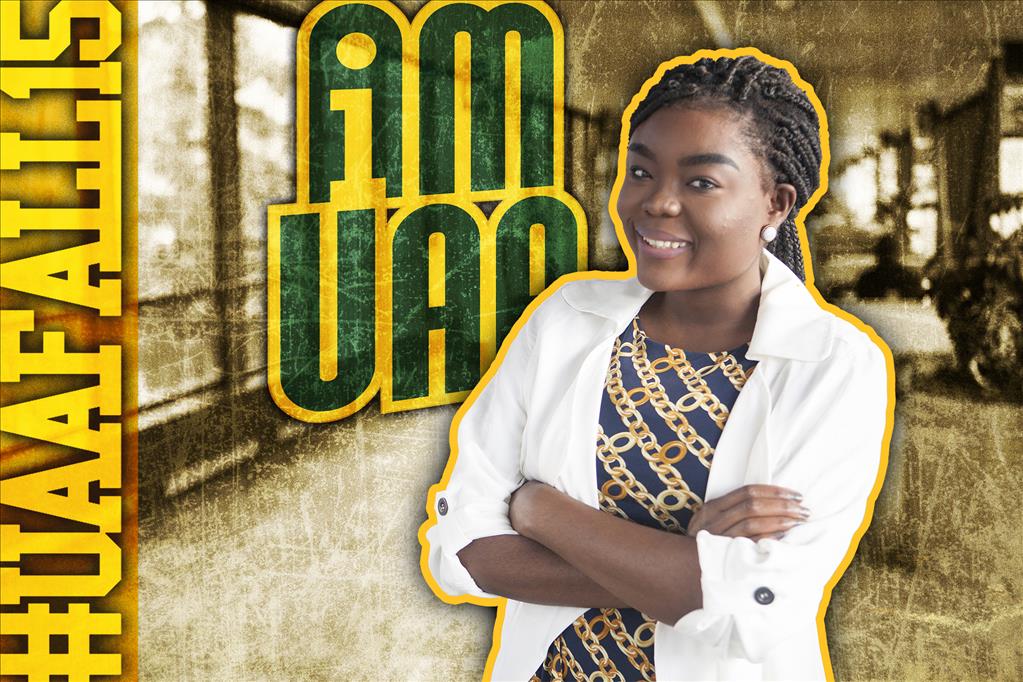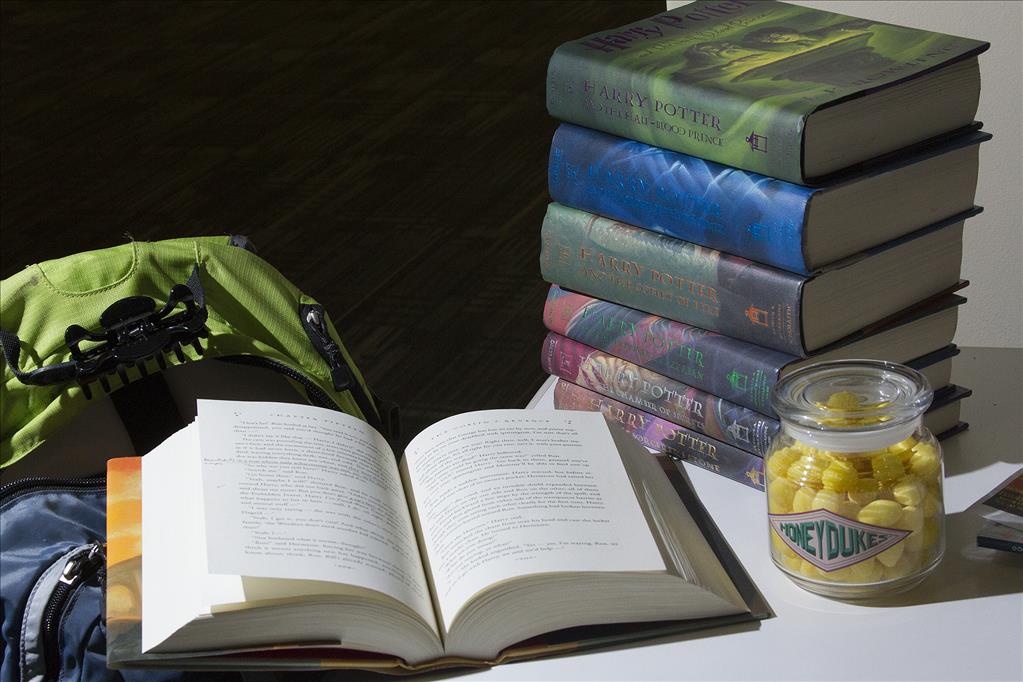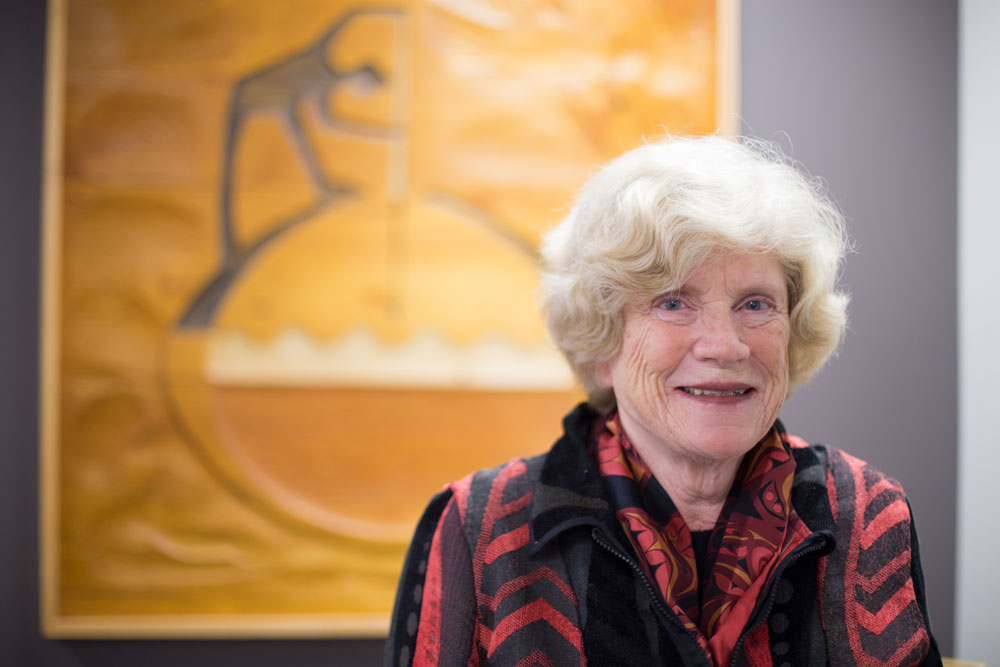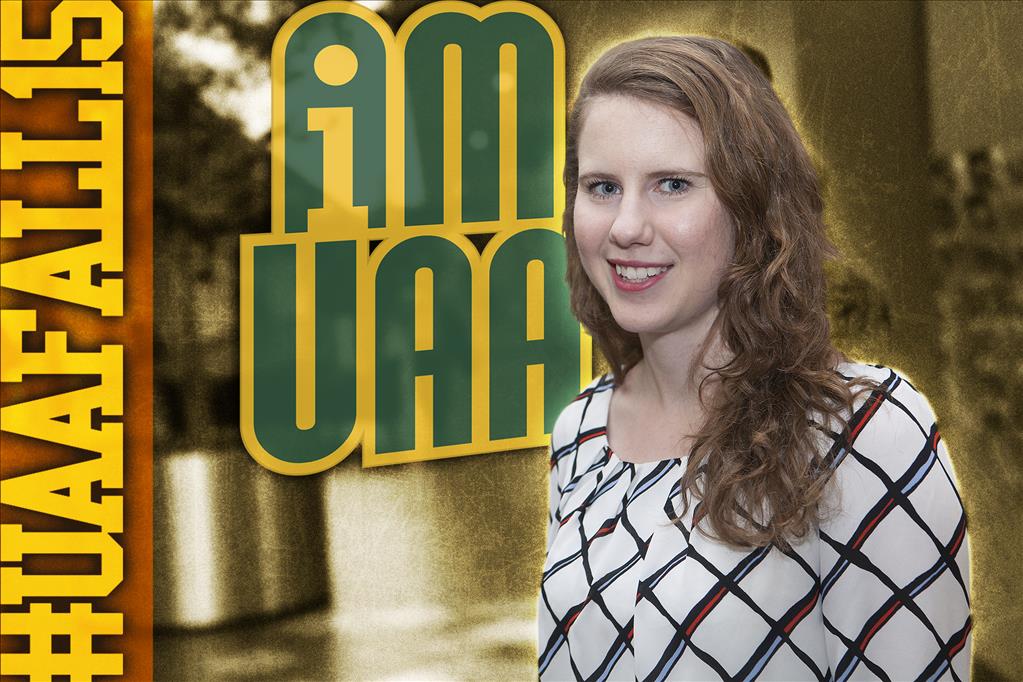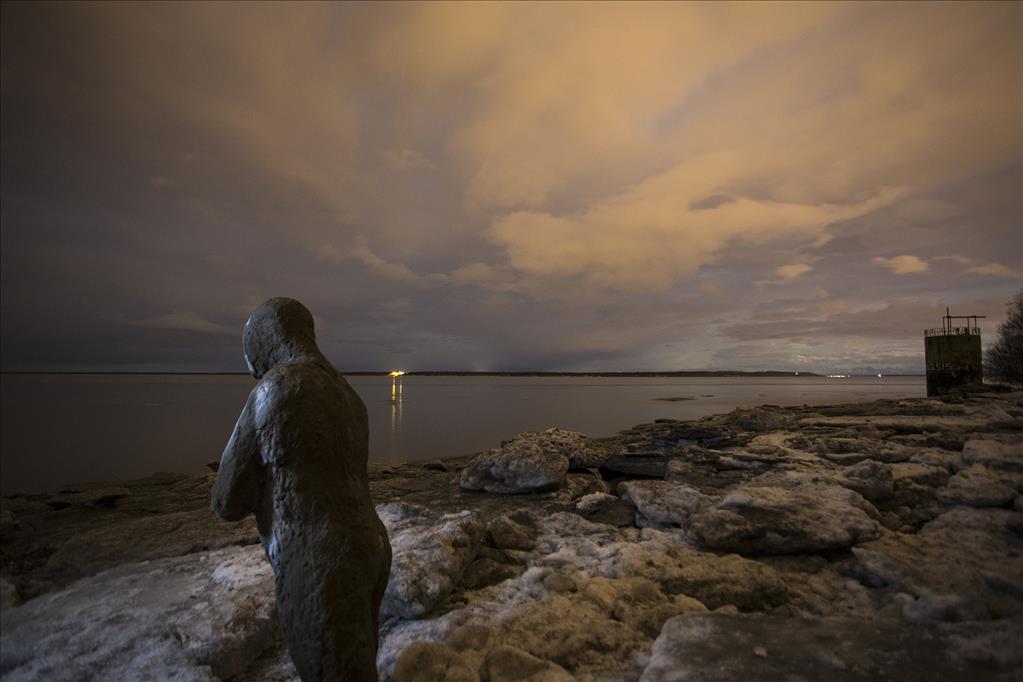Celebrating undergraduate research and creativity
by Tracy Kalytiak |
They've toiled in UAA's labs and library, netted shorebirds on muddy Western Alaska sloughs, yanked philosophy out of its armchair and thrust it into everyday life. They're studying cancer, probing biases and refining a device that could help scientists learn more about concussions.
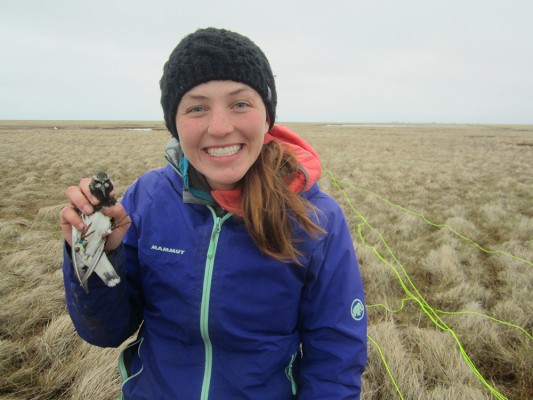
Tesia Forstner won this year's Fran Ulmer Transformative Research Award for her work with black turnstones in Western Alaska. (Photo by Kristine Sowl/Yukon Delta National Wildlife Refuge)
All year, UAA scholars and artists have focused attention and passion on these and many other scholarly and artistic projects they hope might transform their community and the world. They presented their work recently in the UAA University Honors College's Undergraduate Research & Discovery Symposium, in the wake of student presentations during the 2015 Student Showcase.
Honoring excellence
The first Undergraduate Research & Discovery Symposium took place in 2007 when UAA established the Office of Undergraduate Research. Undergraduate research grants are funded internally by UAA and other donors give money for specific prizes.
"Part of the requirement in applying for a grant is that you agree to present," said John Mouracade, interim dean of UAA's Honors College. "We require this because we're teaching students to do research, and part of teaching them to do it is to go from the proposal to the presentation. But we also want to celebrate what they've been doing, we want to showcase it so people can see the great work that's going on ... and they can see the names of the faculty who have mentored as well, so it's a way of honoring those faculty for their extra work."
Approximately 40 students took part in the Symposium, which featured a keynote speech by NASA astronaut Dr. Tracy Caldwell-Dyson Thursday, April 16, at Wendy Williamson Auditorium.
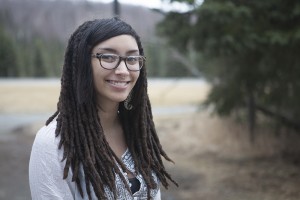
Kierra Hammons was among 23 students who presented their best work at the 2015 Student Showcase. (Photo by Philip Hall/UAA)
Other Symposium events included:
• Poster fair on Monday, April 13-Thursday, April 16, at the UAA/APU Consortium Library. • Research presentations from 8 a.m.-2 p.m., Friday, April 17, in Rasmuson Hall, rooms 110, 210 and 220. • Poster presentation session and reception from 3-4 p.m. April 17 in the Rasmuson Hall lobby. • Awards ceremony 4-6 p.m., April 17, Rasmuson Hall 110.
Another 23 students presented their work during the Student Showcase, which took place April 9-10 in Rasmuson Hall.
'The turnstones have a lot of attitude'
One Symposium presenter, Tesia Forstner, last summer flew to Chevak and then traveled 40 miles by boat to a tributary of the Kuskokwim River. "It is this nirvana for birds; when you go there, you have to be really careful not to step on eggs," said the UAA senior, who won this year's Fran Ulmer Transformative Research Award for her work.
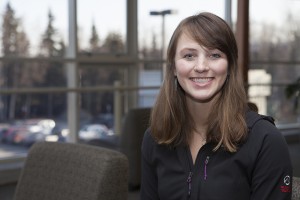
Tesia Forstner presented her research about black turnstones during the 2015 Undergraduate Research & Discovery Symposium in April. (Photo by Philip Hall/University of Alaska Anchorage)
Forstner was working on a Prince William Sound Science Center project in which her UAA faculty mentor, Dr. Audrey Taylor, is involved.
The project's purpose? Finding out what happened to black turnstone populations that abounded on Montague Island until the 1989 Exxon Valdez oil spill.
"When birds migrate, they have stopover sites," Forstner explained. "One of those sites was on Montague Island. After the spill, they stopped showing up. They're thinking herring populations plummeted after the spill-and black turnstones eat herring. They don't know if the population was depleted or just moved elsewhere."
Forstner, Taylor and a few other researchers camped near that Kuskokwim tributary to locate and net 30 birds others had saddled with geolocators the previous year.
"The geolocators look like mini jetpacks," the environmental sciences major said. "I wasn't a birder before, didn't know anything about them. Every species has a personality. The turnstones have a lot of attitude. They're kind of chunky-looking for a bird, kind of fat. They just have a lot of sass. Catching them can be kind of tricky because they're intelligent, adaptable to your methods-it's hard to catch them more than once. There's nothing I've enjoyed more than holding one of those little birds."
The researchers caught 18 of the 30 "jetpacked" birds. They'll use data they collect to learn more about where they birds traveled.
Why study shorebirds? Why chop up their feathers to study stable isotopes found in the fragments?
Forstner says answers scientists find are critical to preserving a healthy environment for humans as well as birds and other animals.
"It's a little silly to me to think there's parts of the environment that aren't important," Forstner said. "You're taught in elementary school there are food webs and we know there are food webs because it's complicated. The one thing I've really learned is that everything is entirely connected. So it seems silly you would disregard a bird species, especially a migratory one, because that's even more complicated. They're not ecological indicators because they move, but they're a piece of a really complicated puzzle."
Tapping into bias
How do you feel about men and women who have tattoos? Do you think they're more prone to become criminals or drug users? Or, do you believe they're free spirits expressing their individuality?
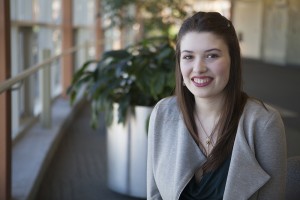
Kivalina Grove researched attitudes about people with tattoos for her Symposium project. (Photo by Philip Hall/University of Alaska Anchorage)
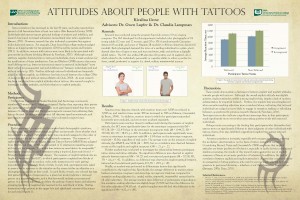
Kivalina Grove participated in the Undergraduate Research & Discovery Symposium, presenting her research into attitudes about people with tattoos.
Today, close to a fourth of all Americans have at least one tattoo, according to 2010 statistics from Pew Research Center.
However, research has indicated pervasive bias against individuals with tattoos, even though no difference has been found between the college grade-point averages of students with and without tattoos.
Kivalina Grove received an undergraduate research grant for her exploration of explicit and implicit attitudes about people with tattoos.
Her research, expanding on a previous study done by students at the University of Tennessee and completed under the guidance of Dr. Gwen Lupfer and Dr. Claudia Lampman, earned the senior psychology student a place in the Symposium.
"Nobody's looked at the implicit attitudes toward people with tattoos," she said. "Implicit attitudes are your gut reaction when you first turn and look at something. You have people look at pictures and words and they have to categorize them."
Grove says 36 participants in her study started by using a computer to categorize images of people with tattoos seen at the same time as negative words, she said.
"So if they see a picture of a person with a tattoo, they press one key," she said. "They see a picture of a person without a tattoo, they'll press the other key. They see a bad word, they press the same key as the tattooed people and a good word is the same as the nontattooed and then they switch. You look at the difference in reaction time and if there's a significant difference, it's indicative of an implicit bias. We found a huge implicit bias."
There's a mild explicit bias against people with tattoos, but for the most part it's "pretty positive," she said.
Why is that "huge" implicit bias important? It's critical because implicit bias informs decision-making when you're not aware it might be a problem, Grove said.
"So if you're a manager and you're looking at hiring two people and you have one person who's tattooed and one person who isn't and you're not consciously thinking, "Oh, I need to be careful that I'm not taking their tattoos into consideration, it's easy to implicitly have a bias against the tattooed person as opposed to the nontattooed person," she said. "So if you have to make quick snap judgments, you're likely to use your implicit attitudes rather than your explicit attitudes."
Learning more about concussions
Anna Hamre and Kolaiah Baker presented information about their design of an ergonomic wireless instrumented mouth guard-helmet prototype. Their work won an Alaska Heart Institute grant.
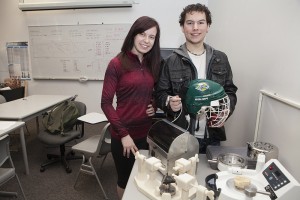
Kolaiah Baker and Anna Hamre earned an Alaska Heart Institute grant for their work on this instrumented mouth guard, designed to glean information about impacts that could cause concussions in athletes. (Photo by Philip Hall/University of Alaska Anchorage)
UAA's Dr. Anthony Paris has been developing the mouth guard for several years, as a way of measuring the force of head impacts that occur as athletes play sports like hockey, football and soccer. UAA's Dr. Jennifer Brock and Dr. John Lund, formerly of UAA, have also worked on the mouthguard project.
Hamre and Baker, both mechanical engineering majors who graduated in May, advanced the project when they started working in August on using a 3-D printer to create an accelerometer mounting device (AMD). Another student, Han Saelor, also participated in the work.
The AMD correctly places an imprint to seat tiny accelerometer chips into an acrylic mouth guard shaped over a stone cast of a UAA hockey player's teeth. The accelerometers measure local accelerations of the player's mouth guard, which are then transmitted wirelessly to researchers who translate the data to the center of gravity of the player's head.
"It was a lot bigger than this," Hamre said of the mouth guard. "We were able to make it a little smaller, so it's not as invasive into a player's mouth. This is the first time we've been able to take this in the field; they've been only doing lab tests." Before, the students had to send a mouth guard out to have the accelerometers placed inside.
"Now, in 30 minutes we can have our mouth guard ready instead of having to wait three weeks," Baker said.
It's a project they hope will make it possible for researchers to gather more data and someday correlate the impacts to some sort of brain injury. "If something happens, cognitively, we'll have the quantitative data behind that," Hamre said.
"And if nothing actually happens, if there's no concussions, then we'll still have all the data," Baker said. "Like, oh, this brain experienced this many G's of acceleration and still did not get a concussion. That's still good stuff."
Hamre wants to continue taking part in moving the project forward, even though she is graduating.
"I want to be involved in the research, I want to be involved in the science, I want to be involved in making it something that's going to change the way we help our athletes," she said.
Seeing the world in a fresh way
UAA's 2015 Student Showcase highlighted the extraordinary work of students throughout the UAA system, which includes campuses in Homer, Mat-Su and Kenai, creating an opportunity for dialogue among community and university members.
Students submitted their best work from the 2014 semesters and a faculty member of the submission discipline performed an anonymous review. Projects that earned the highest marks were presented at the showcase and distinguished people from the community critiqued the students' creations.
Kierra Hammons presented at Student Showcase a project she created for a service learning in applied ethics class.
"Basically you take a community issue, and then you apply philosophy to it and give a presentation about it to the relevant parties and try to make a difference," she said. "We're trying to move away from armchair philosophy to actually getting out and making a difference the community appreciates and can benefit from."
Her project focused on Title IX issues at UAA. (Title IX is a landmark federal civil right prohibiting sexual discrimination, sexual assault and sexual harassment). "That was relevant because we were under review by the Office for Civil Rights," she said. "I went to focus groups for the OCR, I spoke to the Title IX investigators, the Title IX director, and I got a sense of how Title IX claims are being handled here at UAA. I gave some suggestions to help the university communicate with students in a way that's safe and productive and come up with solutions in a focus group setting in order to solve some of those problems they identified."
One problem, Hammons said, was that OCR evaluated UAA, UAF and UAS and then compiled all the data.
"We're three separately accredited institutions and I'm sure each institution does something right that the others can learn from and each institution does something wrong that probably needs some work," she said, "but it's hard to tease those things out if all the data is compiled. And that's the issue with the campus climate survey, too. ...By figuring out a way to get down to a university level, figuring out how to group students together, how to make them feel safe, how to teach them to talk and share ideas and argue with one another for what should be done, then we can figure out ways to help our university that's specific to UAA."
Presenters at this year's Student Showcase included:
April 9
7 p.m., Rasmuson 110 • Edmar Carillo, art • Kierra Hammons, philosophy • Erika LeNorman, art, "Mask" • Jonathon Taylor, communications
7:30 p.m., Rasmuson 101 • Ray Dummar, photography • Jordan Norquist, German • Ashley Snyder, Honors College • Maia Wen, psychology
April 10
10 a.m., Rasmuson 110 • Kayleigh Brandt, poetry • Jason Collins, history • John Jaskoski, English • Steffi Kim, psychology
10:30 a.m., Rasmuson 101 • Wolfgang Olsson, climate science • Christopher Baldwin, history • Jacob Holley-Kline, English, • Carolyn Brashar, journalism, "From Television to Tablet"
1:45 p.m., Rasmuson 101 • Nicole Deren, journalism, "Frozen Side of Hell" • Kathryn DuFresne, English, "Funding space program" • Frazier Manfull, history, "Neither Monk nor Holy Warrior" • Trine Musliu, English, "Social Graces of Partying"
2:15 p.m., Rasmuson 110 • Victoria Maxim, art, life drawing • Whitney Grigsby, CIS, kill switches on smartphones • Krystal Madison, English, "Effects on English in Japanese lyrics" "Celebrating undergraduate research and creativity" is licensed under a Creative Commons Attribution-NonCommercial 4.0 International License.
"Celebrating undergraduate research and creativity" is licensed under a Creative Commons Attribution-NonCommercial 4.0 International License.










